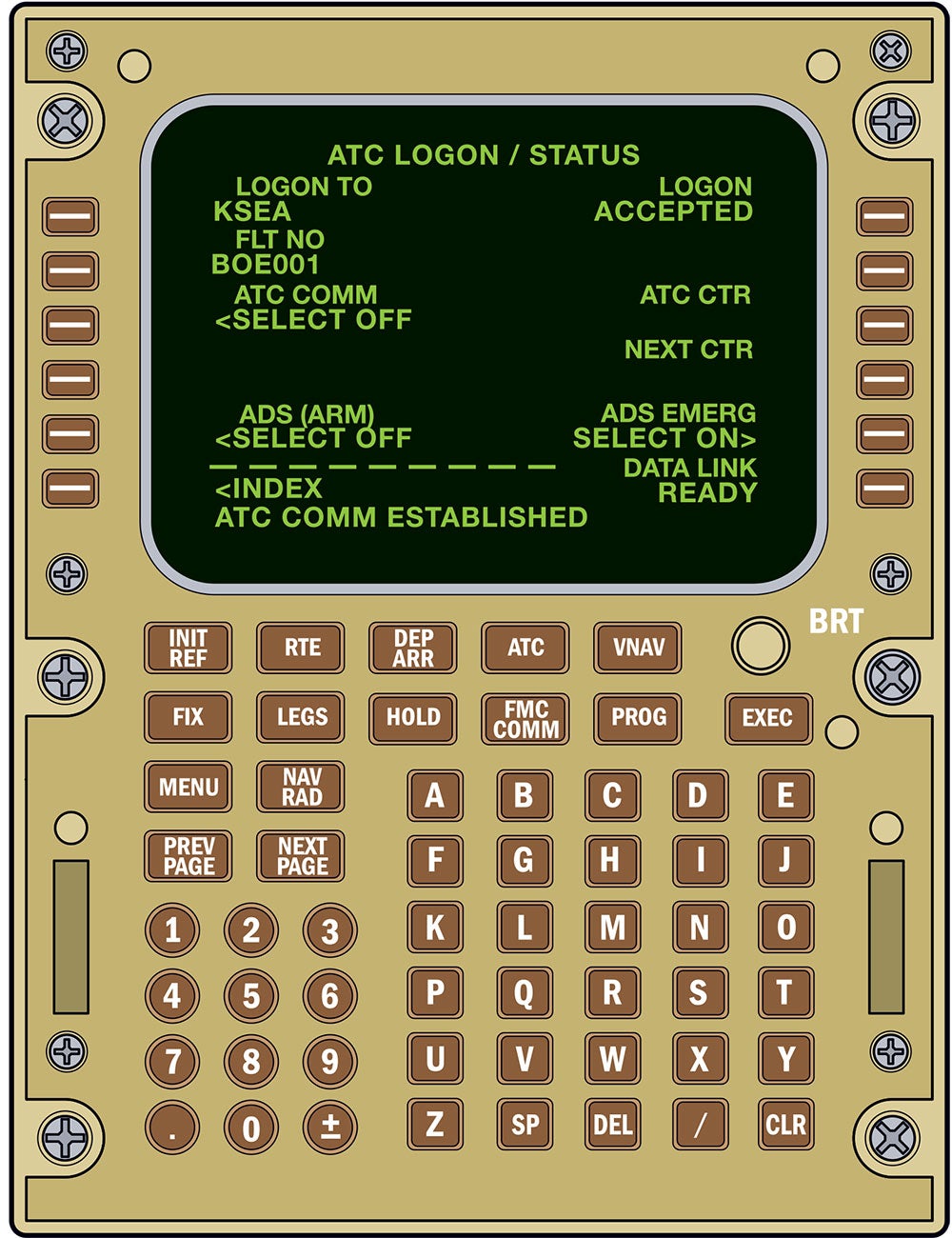1. Satcom
Satellite communication system — Aeronautical mobile satellite service developed as a primary communications link for remote areas and oceanic airspace. Satcom supports voice and data transmissions but is sometimes prone to long transfer delays.
2. ACARS
Airborne communications addressing and reporting system — Air/ground datalink is the standard for ACARS, which has been in use by the airlines for decades. ACARS is used to track aircraft and aircrew flight and block times, cockpit-to-dispatcher digital communications, weather, weight and balance, performance data and so on. ACARS is increasingly being replaced by satcom.
3. FANS 1/A (Future Air Navigation System 1/A)
A NextGen component designed to reduce verbal communication between pilots and ATC because frequency congestion and heavy accents often hinder clear communication. FANS is designed to automate communication among ATC and air/surface traffic. It opens a digital datalink between a pilot and ATC for clearance and position reporting. It’s also referred to as ADS-C (automatic dependent surveillance-contract), and by January 30, 2020, all operations above FL 290 in the entire North Atlantic region will require RNP 10 and FANS 1/A capability.
4. Aireon
ADS-B receivers (launched aboard Iridium Next satellites) promise to provide 100 percent global surveillance of all 1090ES ADS-B Out traffic in real time without the need for additional avionics. Aireon is essentially a space-based extension of ADS-B that bypasses the need to be in range of ground-based receivers. Ordinarily, pilots are able to disable most systems, including ADS-B, for safety reasons. International regulations will soon require automatic transmission of location worldwide without the ability of manual shutdown, with the aim of avoiding another event like the disappearance of Malaysia Airlines Flight 370. Aireon is scheduled to be fully operational later this year if all satellite launches are successful.
5. HFDL
High-frequency datalink — Developed for remote or oceanic use. Low cost, low capacity but high transfer delays.
6. VDL2
VHF digital link Mode 2 — Developed by the International Civil Aviation Organization as an “ACARS-like” system with a faster transmission rate. Datalink messaging slows when use rates are high, and it does not have the capability for voice transmission.
7. VDL3
VHF digital link Mode 3, aka “Nexcom” — Designed to handle both digital and voice traffic. Permits up to four channels to operate on a single 25 kHz band and has the ability to swap bandwidth between voice and data as needed. VDL3 could emerge as the “global standard” if the expectations of the International Air Transport Association, ICAO and the FAA are met.
8. VDL4
VHF digital link Mode 4 — Designed as a data communication link for the ADS-B system.
9. CPDLC
Controller-pilot datalink communications — Exchange of text messaging in real time via satellite link. Now routinely used by state-of-the-art aircraft crossing remote or oceanic areas. Soon to become mandatory equipment for the most desirable long-distance routes all over the world. CPDLC provides clear datalink directives as opposed to translating incongruous “English-is-not-their-native-language” controller accents and annoying static on ancient HF radios.
10. Data comm (data communication)
CPDLC departure clearance (CPDLC DCL, aka data comm) procedures have been implemented at virtually all large U.S. airports equipped with Tower Data Link Services (TDLS). Data comm supplements voice communication between controllers and pilots with digital text-based messages. It enables air traffic controllers to send text-based departure clearance instructions to flight crews of equipped aircraft instead of speaking over the radio. Air carrier dispatchers simultaneously receive the same information. Flight crews review the instructions and signal acceptance by pushing a button, and the instructions are then loaded into the aircraft’s FMS. If plans change, this process can be repeated as often as necessary. Initial en route services in high-altitude airspace are scheduled to start operating next year and be available at all 20 en route centers by 2021. This will enable controllers to provide pilots with frequency handoffs, altitude changes and reroutes. Miscommunications between controllers and pilots known as “talk-back, read-back” errors will be drastically reduced.
11. ADS-C
Automatic dependent surveillance-contract — A datalink position reporting system controlled by a ground station (i.e., air traffic service unit, aka air navigation service provider) that establishes “contracts” with an aircraft’s avionics (via satcom) that occur automatically whenever specific events occur or specific time intervals are reached. These position reports are used to create a track on the controller’s display for flights in remote or (mostly) oceanic areas. ADS-C may also provide real-time weather and other data.
12. ADS-R
A key piece of the ADS-B puzzle for general aviation, automatic dependent surveillance-rebroadcast is a datalink translation function of the ADS-B ground system required to accommodate the two separate operating frequencies (transmitted and received over the 978 MHz and 1090 ES). The ADS-B system receives all of the ADS-B messages transmitted on one frequency, and ADS-R automatically translates and reformats the information for rebroadcast on the other frequency. This allows ADS-B In-equipped aircraft to see nearby ADS-B Out traffic targets regardless of the operating link being used by the other aircraft. Aircraft operating on the same ADS-B frequency exchange information directly and do not require the ADS-R translation function.
